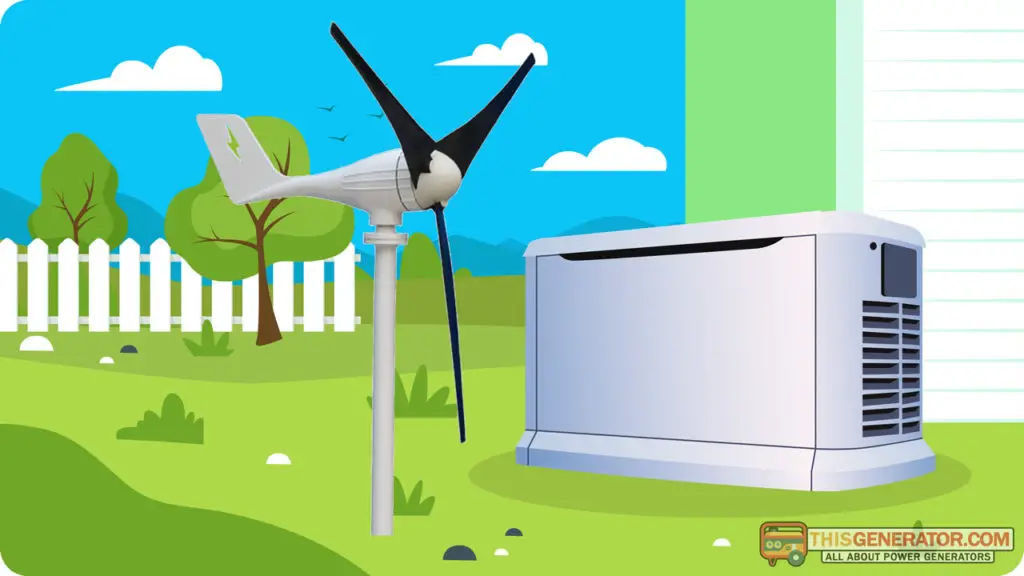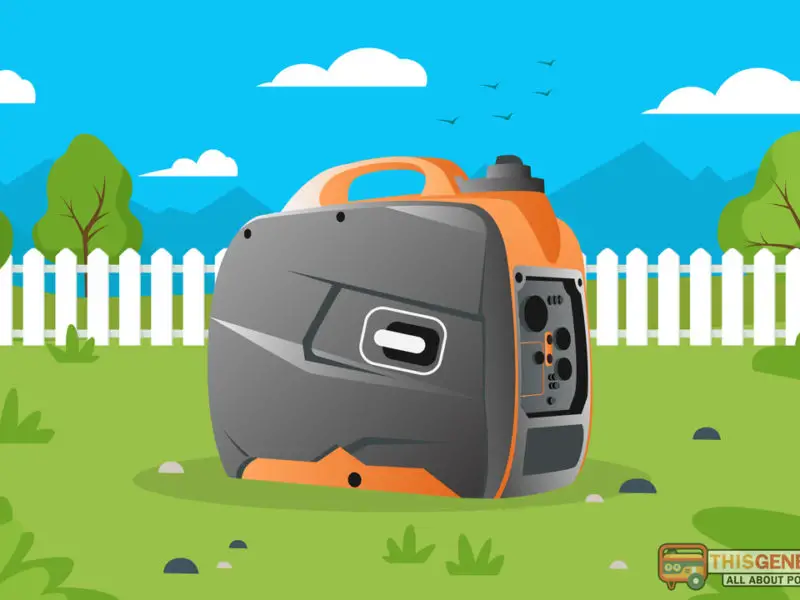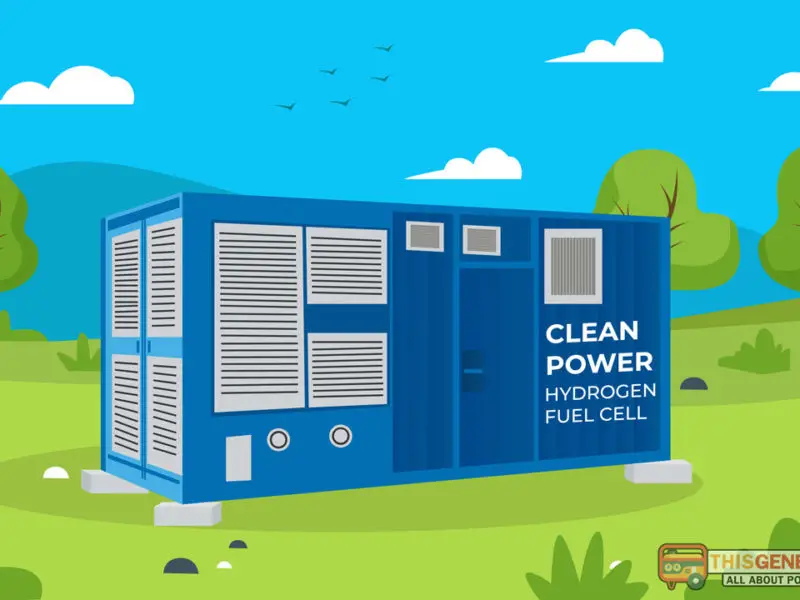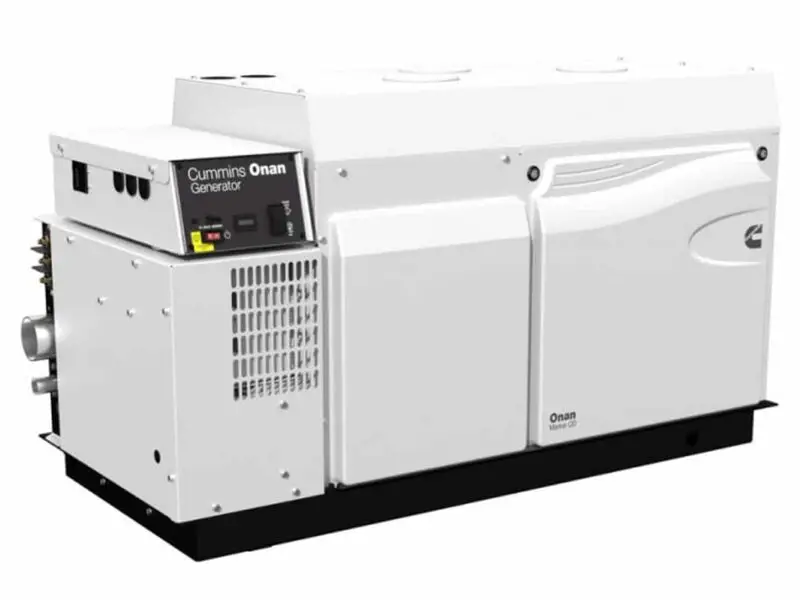Although not yet as popular as gas generators or even solar panels, wind energy has recently become one of the most in-demand backup power technologies in the residential market. Homeowners see it as a cost-effective alternative to grid power. Moreover, wind generators are long-term investments that can last several decades.
Of course, the price issue puts it out of range for many people. According to the American Wind Energy Association (AWEA), it costs a staggering $5,000 and $40,000 to install a wind power system, depending on the output and design,

Nevertheless, we think that a wind power system is an investment worth considering if budget isn’t an obstacle.
Read on to learn how a wind generator works, why you should strongly consider installing one, and critical considerations when shopping for a wind power system. We later also review some of the best wind generators to consider.
What is a Wind Generator?
A wind generator is just another name for a wind turbine. A wind turbine is a device that converts the wind’s kinetic energy into electrical energy. Wind turbines comprise blades that spin when wind passes through them. The rotating turbines, in turn, spin a shaft/coil built into the turbine’s motor.
Remember that motors have a spinning coil sandwiched between two magnets with different polarities. As such, the spinning shaft/coil generates an electromagnetic field, ultimately initiating electron flow that forms an electric current.
How Does a Wind Turbine Work?
Home wind turbines comprise a rotor, a generator or frame-mounted alternator, tail, tower, and wiring. In addition, the systems also have a balancing system comprising controllers, inverters, and batteries.
When there’s wind, the blades spin, transferring kinetic energy to the rotor. The rotary motion drives the generator/alternator, generating alternating current, albeit unstable. The controllers and inverter work side-by-side to stabilize the current and ultimately create stable AC power available via 30A AC, 20A AC, and DC outlets.
Wind turbines are either horizontal axis or vertical axis. Horizontal axis wind turbines (HAWTs), the most common today, comprise two or three blades and rotate parallel or horizontal to the ground. Meanwhile, vertical axis wind turbines (VAWTs) rotate perpendicular or vertical to the ground. VAWTs come in two main types, Darrieus (egg-beaters) and Savonius (wind scoopers).
Wind turbines may or may not have storage batteries. Generally, you need batteries for a standalone system that doesn’t connect to the grid.
Is Wind Energy Practical for Me?
This is a very important question considering the high cost of installing a wind turbine. A small wind energy system is practical for you if;
- Your property has a good wind source
- Your local codes permit wind turbine installation
- Your home is located on at least an acre of land
- You are happy to spend the required budget
Of course, you also need to ask yourself whether wind power represents your best solution. For instance, some locations work better with solar power, which is just as effective. Or, you may even consider a mini hydroelectric power station, which is typically even more reliable.
If wind seems the best solution, the next step is to follow up with the local authorities to determine whether your zoning laws allow for wind power installation. You should also consider visiting the Distributer Wind Energy Association’s Permitting and Zoning Resource Center to find out what you need to get a permit.
Most states charge a permit fee. For instance, the wind turbine permit costs $1,000 to $5,000 in San Francisco. So, budget accordingly. You’re ready to start thinking about getting and installing a turbine after passing the permit test.
Is There Enough Wind on My Site?
Next, you need to check whether you have enough wind on the site before installing a wind turbine. In fact, you should test the wind strength before you even pay for the permit.
Wind experts recommend installing an anemometer, a device that measures wind speed and direction, at least 12 months in advance to help you determine whether you can generate enough electricity from the wind on your property. Additionally, make sure to check the state wind maps for guidance.
However, you may want to know the strongest winds in the US are found along the coastlines, on ridges, and on the Great Plains.
Top Considerations When Shopping for a Wind Turbine
Once you’ve determined that your site has enough wind power to generate power, the next step is to go shopping for a wind turbine. The following considerations should help you get your choice right.
- What Size Wind Turbine Do I Need?
The size of the turbine you need depends on how much electricity you wish to generate. For instance, if you’re solely concerned about powering your home, the average American home uses about 10,649 kilowatt-hours of electricity per year, according to the Office of Energy Efficiency & Renewable Energy. So, you should be able to go off the grid completely with a 5-15kWh wind turbine. However, you only need 400 watts to 1,000 watts for charging appliances and running the entertainment system.
- Blade size and number
The number and size of blades on the turbine are also critical factors. Typically, fewer blades result in faster motor rotation, thus more electric current produced per unit time. Meanwhile, more blades tend to encounter more resistance (drag), resulting in lower speeds. The blade’s size (especially the length) also matters as longer blades require a wider buffer zone, thus are unsuited to urban areas.
- Wind speed rating
A wind turbine’s speed rating refers to the average wind speed needed for the turbine to work at peak output. Granted, your turbine will still put out power even at low wind speeds. However, it can only hit the listed energy output at the rated wind speed. Thus, you should consider models with the lowest possible wind speed ratings, as these turbines attain the listed power output more easily. Wind speed ratings typically range from 15 mph to 30 mph.
- Weight
Weight isn’t one of the most important factors when choosing a wind turbine. However, it’s still important as the weight directly determines the type of tower you need to support the turbine. For instance, while you can install a light turbine on the roof, a sturdy tower is a must for heavier wind turbines.
- Features
Finally, you must also consider the equipment’s bells and whistles – the little details that make it stand out. For instance, an automatic braking system is a vital advantage over standard turbines. Charge controllers and low-wind efficiency are other valuable features. Finally, protective coatings, such as marine, anti-UV, and anti-corrosion coatings, are substantial difference makers.
How Much Energy Will My Wing Power System Generate?
According to AWEA, a wind power system’s rated annual energy output is the calculated total energy the wind system would produce over a year at an average wind speed of 5mps or 11.2mph.
The formula is as follows: P = Cp1/2 ƿA
Where:
P = Power output in watts
Cp = Maximum power co-efficient.
Ƿ = Air Density in kg/
A = Root swept area in square meters
V = Wind speed in m/s
Note that;
- The Maximum power coefficient ranges from 0.25 to 0.45 and is dimensionless. The theoretical maximum is 0.59.
- You can easily calculate the rotor swept area if you know the diameter of your turbine motor. A = π/4 where D is the diameter of the rotor in meters and π = 3.14.
- The wind speed has a factor of three applied to it, i.e., it’s raised to power three. This means that even a slight increase in wind speed produces a significant power increase.
It means you can increase your wind generator power output by manipulating two factors, i.e., the swept area and the air density factors. We recommend the following;
- Find a larger rotor: A larger rotor directly impacts the root swept area (A), which, in turn, impacts wind capture. Typically, the larger the motor, the greater the wind capture.
- Choose an elevated ground: Wind density, ƿ, is directly correlated to temperatures and elevation. It means, therefore, that raising the elevation of the installation can significantly boost power output. We recommend installing the turbine at least 30 feet (9.0 meters) above any obstacle within 300 feet of the tower.
Product Reviews
Now that we know better about wind power systems, let’s review some of the best wind generators to consider in 2022 and onwards. Keep in mind that wind power systems typically come in kits. A typical kit comes with all the wind generator components, including installation materials and guidelines.
WINDMILL 1500W Wind Turbine Generator Kit
- 【Effective Generation】Maximum power generation of 1500W of DC power at 24V or 48V,...
- 【Powerful Applications】 Our 1500W can help cover electricity costs for some users,...
- 【Environmentally Friendly】Take a stride towards sustainability with our windmill. Designed...
Pros
- Powerful at 1,500 watts
- It has an automatic and manual braking system
- Weather and damage resistant
- Protective UV coating
Cons
- One year warranty is too short
Let’s begin with the majestic 1500-watt wind turbine from WINDMILL. This is, by far, one of the best wind generators overall. It weighs just 33 pounds and comes with a 6.0 mph cut-in speed and a built-in MPPT charge controller.
We also love that this wind generator has an automatic braking system. The braking system forces the wind turbine to stop in case of wild winds that may break the blades. The turbine has three blades and blows at 46 feet per second thanks to the 6-foot rotor radius.
Other features of the WINDMILL include glass fiber and polypropylene exterior protection for resistance to weather elements such as rain and the sun’s UV rays. The 24V wind generator is compatible with 200A or larger batteries and comes with a one-year warranty.
TUMO-Int 1000W Wind Turbine Generator Kit (with Boosting Controller)
- [Low Noise] The aluminum alloy case of the wind turbine is light and pretty, low vibration.
- [High Efficiency] Optimized design of aerodynamic contour and structure enable the generator to...
- [Safe and reliable] Adopts mechanical and electromagnetic dual over-speed control design,...
Pros
- Powerful energy output at 1,000 watts
- Low cut-in speed
- 3-year warranty
Cons
- Quite large and heavy
- It’s a tad expensive
The 1000-watt TUMO-International turbine is considered the most eco-friendly wind generator. It’s a funny unit because you may think it’s a small-scale industrial turbine at first glance. However, the 3-blade wind generator works excellently in domestic settings. It installs with ease and is also easy to maintain.
Its 48V storage battery definitely stands out. It means you can store tons of power for the off days. Additionally, we love the generator’s low starting speeds. It starts at just 5.6 mph, meaning you can start getting power even without strong winds. Better still, the TUMO generator can survive in environments up to 90 mph, making it practical in harsh environments prone to tornadoes, hurricanes, and heavy storms.
The generator produces up to 1050 watts at peak efficiency and boasts an MPPT controller and dump load to detect and regulate charge in real-time. It uses heat-resistant Teflon wire and a corrosion-resistant wheel shell for maximum longevity.
Shzond 12V 400-Watt Hybrid Wind Turbine Generator
- Well suited for the leisure sector, it is famous for battery charging on boats, gazebos,...
- Wind generator rated power: 400W;Rated Voltage: DC27-54V;Battery Voltage:DC12V;Number of...
- Material of Wind Leaf: PBT;Start-up Wind Speed: 2.5m/s(8'/s);Rated Wind Speed:...
Pros
- Rated at just 12m/s
- Has a low starting speed of 2.5m/s
- Multiple protection features
- Decent build quality
Cons
- Too small at 400 watts
Shzond is a relatively new brand in the wind power sector. However, their 400-watt wind turbine kit is definitely one of the best wind generators around. For one, it’s rated 12m/s, making it one of the most reliable units, even in areas with low wind speeds. The low startup speed of 2.5m/s is just as impressive.
The turbine has three blades made from polybutylene terephthalate for powerful performance and long life. It can put out up to 1.4 kilowatts in a day. Each blade is protected by reinforced glass fiber and shaped aerodynamically for maximum efficiency.
The best part, however, is the installation process. The Shzond wind turbine installs with ease. The installation kit comprises every item you need to set it up. It even has battery overcharging protection and discharge protection. The unit can last up to 15 years, according to the manufacturer.
Dyna-Living Wind Turbine Generator 400-Watt DC 12V
- [Low Noise and Durable]- The wind turbine motor adopts a three-phase DC permanent magnet...
- [High Wind Energy Utilization]-The coil is made of Teflon wire, which is resistant to high...
- [High-Quality Blades]-The blade is equipped with a copper inlay part that does not damage the...
Pros
- Easy installation and maintenance
- Unique motor reduced resistant torque
- High quality- durable blades
- High wind utilization rating
- Low noise output
Cons
- Only one year warranty
Another 12V system worth considering when shopping for a wind turbine is the 400-watt system from Dyna-Living. It’s an entry-level turbine with three blades like most wind power systems. It also comes with a wind controller like bigger wind systems. However, there are a few things to keep in mind.
The wind turbine adopts a three-phase DC permanent magnetic synchronous generator that runs freely with little noise and for long service life. The motor also utilizes Teflon wire which is heat resistant and not easily damaged even when the generator is overloaded. We also love that the generator has a high wind energy utilization.
The generator’s blades are also of the highest quality. They feature a copper inlay that doesn’t damage the nylon fiber even when you tighten the bolt. Moreover, the blades continue to operate well in temperatures as low as -40F and as high as 80F.
2000-Watt 11 Blade Missouri General Freedom II
- Metal components are fully hot dipped galvanized, hub is zinc plated - Will not rust - No need...
- Raptor carbon fiber blades withstand 125 mph - Guaranteed for a lifetime, not to break under...
- The permanent magnet generator has a 28 rare earth magnet rotor inside and our skewed stator...
Pros
- Powerful 2,000-watt output
- 11 carbon fiber blades
- 28-magnet rotor motor
- Self-tightening cam-lock locker
- 3-year warranty
Cons
- Average cut wind speed
- Its ball bearings wear out fast
Now, let’s look at the most powerful wind generator on this list, the Freedom II from Blade Missouri. Although 2,000 watts is still not enough to power an entire house, it comes very close. You may only need a few more kilowatts from your supplier.
The wind generator has a powerful motor made from 28 rare earth metals and comprises 11 blades – the highest on this list. Thus, it has a poor cut-in wind rate of just 6.0 mph and a wind speed rating of 15mph. However, it can handle extreme winds up to 125mph!
The unit’s battery charges much faster than comparable wind generators, thanks to a higher quantity of copper in the PMG motor. You can opt for a white or black unit and get a 3-year warranty, whichever the choice.
HappyBuy 700W DC 24V Generator
- ♻[MAIN PARAMETER] ~ Rated Power: 400W ; Rated Voltage: DC 12V ; Battery Voltage: DC 12V ;...
- ♻[CONTROLLER INTRODUCTION] ~ Model: FWS03/06-12 ; Battery Rated Voltage: DC 12V ; Rated...
- ♻[HIGH-QUALITY BLADE] ~ The blade material is synthetically injection molded with...
Pros
- Powerful 3-phase AC PMG
- High-quality carbon fiber blades
- Quiet, smooth operation
- 0.6m/s starting power
- 0.3mps rated wind speed
Cons
- No manual braking component t
- Low overall power output
The HappyBuy Turbine Generator is another worthy contender when shopping for a wind power system. At 700 watts (peaks at 720 watts), it’s not the most powerful wind generator on this list. However, the 24V turbine is one of the most durable wind turbines. The nylon fiber blades, protective coating, and dual bearings ensure a long life of valuable service.
It features a 3-phase AC PMG (permanent magnet generator) motor with a powerful microprocessor. The PMG motor ensures accurate and safe voltage regulation and makes the most of high winds. It also increases the unit’s total power processing time.
The HappyBuy’s blades rotate freely and quietly. So, you don’t have to worry about loud noises from your wind power station. The fixed dual bearings provide stability, giving the unit a low wind start speed. It has an electronic braking system for safety.
Eco-Worthy 24V 600-Watt Wind Generator
- [Ideal Output]: The ideal daily power generation of our 600W Solar Wind Power Kit is up to...
- [Solar Panel]: High efficiency monocrystalline solar panel is your best choice for off-grid...
- [Wind Turbine Generator]: 400W wind turbine solve the problem that solar panels could not work...
Pros
- Includes hybrid controller
- It has a solar panel for multifunctional use
- High-quality blades
- Pure sine wave converter
Cons
- A tad bulky at 64 pounds
- Low wind power output
Finally, if you want a complete alternative power system, we strongly recommend the 600-watt unit from Eco-Worthy. This kit comprises a 400-watt power turbine and a 100-watt solar panel, so you’re not left in the dark on not-so-windy days.
The wind turbine has a hybrid controller with 12V, and 24V auto-detect capabilities. This way, you can connect the battery to the controller then link the wind turbine and solar panel to the controller. It has a 5mps wind cut-in speed and 15mps rated wind speed.
Other key features of the 3-blade Eco-Worthy wind power generator include a 2-meter rotor diameter, carbon fiber composite blades, pure sine wave converter, and permanent Magento phase generator style. It weighs 64 pounds.
LOYALHEARTDY Wind Turbine Generator, 24V 600W 5 Blades Vertical Axis Wind Turbine Kit
- ☀ Using reinforced nylon fiber on wind wheel blades and the aerodynamic lantern shape design,...
- ☀ Low start up wind speed, high efficiency, small size, low vibration. The shell is made of...
- ☀ Wind Turbine using permanent magnetic generator together with the special stator design,...
Pros
- Aerodynamic lantern shape design
- 5 blade vertical axis wind turbine with large air volume
- More stable than the 3-blade wind turbine.
- Low wind-speed startup
- Multiple energy sources
Cons
- Not perfect for stormy winds
LOYALHEARTDY Wind Turbine Generator is best for those looking for a unit that maximizes both wind and solar energy. It includes a high-performance permanent magnet generator and a special stator for smooth operation.
The LOYALHEARTDY excels at wind as well as solar hybrid power systems. This means you enjoy both energy sources on a windy and sunny day.
Plus, it is a five-blade vertical axis and can start generating power at low wind speeds of 2m/s. It’s also resilient and works even under low temperatures of -104 to -176 degrees Fahrenheit. This makes it perfect for use in multiple locations, including at home, camping, or on boats.
Overall, The 24V 600W wind turbine generator is a versatile performer perfect for those after a multi-purpose turbine.
Vertical Spiral Wind Power Turbine Generator, 800W 12V/24V/48V
- [Safety design]-Low starting wind speed, high wind energy utilization,The blade material is...
- [Available 360 Degree Wind]-Designed with three-phase AC PMG, it boasts low torque, high-power...
- [Super quiet]-With dual bearings, the fan movement is more stable. Low vibration and low noise....
Pros
- Optimal wind-energy utilization
- Magnetic levitation axis ensures stability and efficiency
- Good safety performance
- Simple structure
- Blade air resistance is small
- Reliable operation and easy maintenance
- Sturdy structure with resilient FRP material
Cons
- Not as portable as other wind generators
The Vertical Spiral Wind Power Turbine Generator features a unique design– it isn’t what you’d expect a turbine to look like.
Still, it’s perfect for those looking to get the most out of their wind power. This generator can produce up to 800W of power, making it great for your small power needs.
The generator’s unique vertical spiral design helps it start quickly, even in low wind conditions. While in motion, its magnetic levitation axis ensures that it stays stable and efficient in high winds. Additionally, the generator’s 12v/24v/48v output makes it compatible with a variety of different power needs.
The Vertical Spiral Wind Power Turbine is a great option if you’re looking for a home power supplement or backup unit. With its high output, stable design, and compatibility with various power needs, this generator will certainly meet your needs.
FAQs
How Much Do Wind Turbines Cost?
Depending on the wattage rating, a small wind energy system costs between $5,000 and $40,000. VWATs are typically cheaper, costing $5,000 to $15,000 before installation. However, don’t forget about permitting fees. The good news is that wing generators pay for themselves after about 15 years.
Where are wind turbines mounted?
Wind turbines are best installed on a raised tower to overcome obstructions and ground turbulence. Generally, you want to install the turbine on a pole or tower. The higher the pole or tower, the more power the wind turbine can produce. It’s also best to install the generator on a raised ground.
Where can I find installation and maintenance support?
The Small Wind Certification Council (SWCC), National Renewable Energy Laboratory’s (NREL’s) National Wind Technology Center, and Interstate Turbine Advisory Council (ITAC) are the three best resources to find installation and maintenance support. ITAC
Can I connect my system to the utility grid?
Yes, you can connect a small wind energy generator system to the electrical distribution system. In fact, you should strongly consider doing so, as connecting your wind power to the grid reduces your utility-supplied electricity consumption. Also, the utility can easily make up the difference where your wind generator comes short. Above all, the supplier can buy your excess power through net billing, allowing you to earn an income in the process.
Can I go off the grid?
Yes, you can also go off the grid. It’s not usually the best idea because you may need additional power with time, which your power company can provide if you’re connected to the grid. However, a hybrid power system comprising a wind turbine, solar generator, and diesel generator can create a fail-proof alternative power solution that may allow you to operate entirely off the grid.
Are there any federal or state incentives for small wind turbines?
Yes. At the federal level, owners of small wind systems are guaranteed uncapped federal investment tax credit for 30% of total installed costs. Meanwhile, different states have different incentive programs for wind power installations. For instance, California’s Self-Generation Incentive Program (SGIP) offers wind power rebates at $1.19 per watt for the first 3.0 megawatts.
Summary
A wind generator can be a valuable long-term investment. Installing one means you save on grid power. Better still, wind power is reliable and environment-friendly. The best part is that you can sell excess wind power to your grid power god good money every year. So, it’s 100% worth the investment if you can afford the budget. And now you know some of the best wind generator systems to consider!












